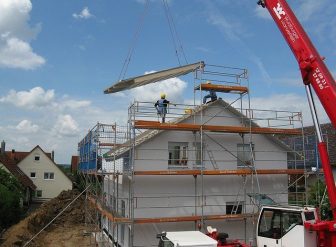 A number of planned residential property developments in London are at risk of not going ahead due to soaring land prices, new research has revealed.
A number of planned residential property developments in London are at risk of not going ahead due to soaring land prices, new research has revealed.
According to Savills, 9% of the total residential pipeline coming forward in London in 2022 could be at risk of becoming industrial as land values for the sector continue to rise.
This equates to the potential loss of circa 130,000 residential units in the capital, putting even greater pressure on constrained residential land supply.
London desperately needs more new homes, but Savills notes that delivery continues to fall short of the current London Plan Housing Target with 16 out of 32 London boroughs now facing planning sanctions as a result of not meeting these targets.
However, the sector is now facing a new challenge from rising industrial land values, with the average price per acre in certain locations increasing by 175% to £8.3 million since 2017. In fact, in core industrial areas, prime industrial land prices exceed this level by a large margin.
Meanwhile, residential land values in London face downward pressure from rapidly increasing build costs, weaker house price growth and lower affordable housing values, particularly in Outer London.
Since 2011, London has lost 5.7 million sq ft of warehouse space to other uses, despite considerable demand for urban logistics.
Locating warehouse facilities close enough to their final delivery points has become essential, especially with online retail set to reach 35% of all retail sales by 2025.
 Research from the British Property Federation suggests that each additional new home requires 69 sq ft of warehouse space to support it. Although the level of new home completions in London is falling, the London Plan recommends that 52,000 new homes should be built per year over the next 10 years. Therefore, meeting this target would require 36 million sq ft of new warehouse space to adequately service new residents.
Research from the British Property Federation suggests that each additional new home requires 69 sq ft of warehouse space to support it. Although the level of new home completions in London is falling, the London Plan recommends that 52,000 new homes should be built per year over the next 10 years. Therefore, meeting this target would require 36 million sq ft of new warehouse space to adequately service new residents.
The adoption of the new London Plan in 2021 set out to alleviate tension between the competing pressures for land, encouraging the co-location of residential and industrial uses and industrial intensification as part of its ‘beds and sheds’ policy. Yet, written in 2016, it did not account for the meteoric rise of industrial and logistics driven by the Covid-19 pandemic.
Mixed use sites where residential and industrial co-locate are coming forward slowly, however Savills is seeing a number of sites previously earmarked for residential development now remaining as higher value industrial assets, representing a new dynamic in the residential land market. Overwhelmingly, these are in cheaper parts of London, where housing need is greatest and markets are most under supplied.
Lydia McLaren, associate in the residential research team at Savills, commented: “The pendulum has swung in terms of values, but also in terms of planning policy and build complexity.
“Residential developers have to contend with moving goal posts, such as the tightening of building standards and sustainability regulation, as well as tax changes, against the context of rapidly rising build costs. This compounding of costs and added risks is challenging the viability of residential, meaning that developers are increasingly outbid by industrial.”
 Whilst intensification solutions seek to enhance capacity on existing industrial schemes through multi-storey development or co-location, there remain few examples of this working in practice. What’s more, these types of facilities are expensive to build and only viable in certain locations where industrial rents outweigh construction costs. Fundamentally, there remains a reticence from both developers and occupiers to embrace these new styles of development.
Whilst intensification solutions seek to enhance capacity on existing industrial schemes through multi-storey development or co-location, there remain few examples of this working in practice. What’s more, these types of facilities are expensive to build and only viable in certain locations where industrial rents outweigh construction costs. Fundamentally, there remains a reticence from both developers and occupiers to embrace these new styles of development.
Looking ahead, with demand continuing for both residential and industrial land, Savills says that policy needs to balance these requirements whilst maximising capacity for development on existing brownfield sites.
Taking on development risk and unlocking difficult sites with fragmented land ownership is another means in which the GLA can help ease the pressure for both sectors. Demonstrating proof of concept of industrial intensification and co-location will also be critical for providing the market with greater confidence.
Kevin Mofid, head of industrial & logistics research at Savills, commented: “With increasing populations, higher levels of online retail and the need for occupiers to locate to more energy efficient buildings, the demand for good quality warehousing is not going to abate any time soon.
“Whilst we are starting to see innovation around intensification, there remains no silver bullet that resolves the ongoing tensions between the different use classes. However, longer term strategic planning across different land uses and greater flexibility around planning allocations to facilitate land use swaps where appropriate, would allow for more efficient re-development.
“Public sector intervention to help prove the concept of an intensified scheme will, in the long term, help the market deliver the solutions required.”


Comments are closed.